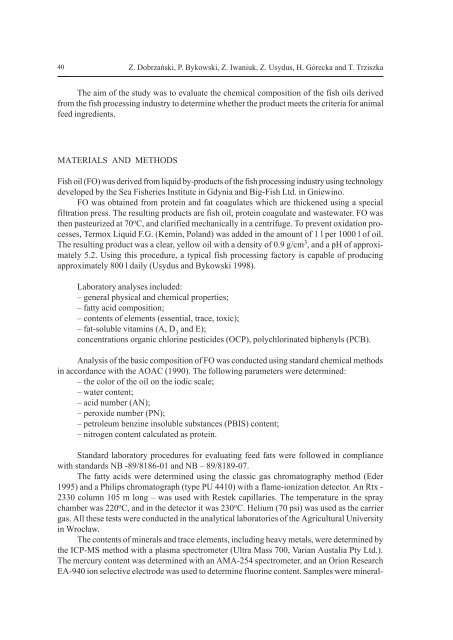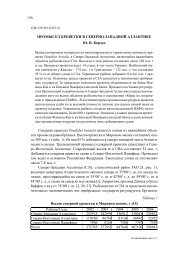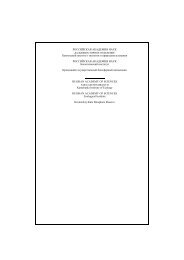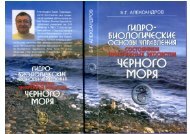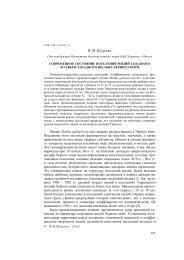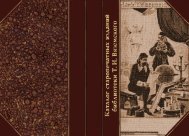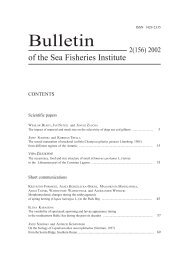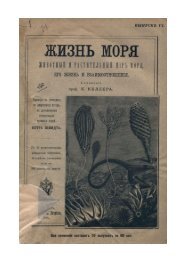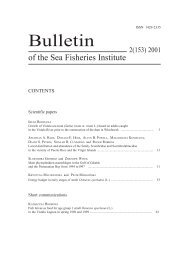Bulletin of the Sea Fisheries Institute 1 (155) 2002 - CEEMaR
Bulletin of the Sea Fisheries Institute 1 (155) 2002 - CEEMaR
Bulletin of the Sea Fisheries Institute 1 (155) 2002 - CEEMaR
You also want an ePaper? Increase the reach of your titles
YUMPU automatically turns print PDFs into web optimized ePapers that Google loves.
40<br />
Z. Dobrzañski, P. Bykowski, Z. Iwaniuk, Z. Usydus, H. Górecka and T. Trziszka<br />
The aim <strong>of</strong> <strong>the</strong> study was to evaluate <strong>the</strong> chemical composition <strong>of</strong> <strong>the</strong> fish oils derived<br />
from <strong>the</strong> fish processing industry to determine whe<strong>the</strong>r <strong>the</strong> product meets <strong>the</strong> criteria for animal<br />
feed ingredients.<br />
MATERIALS AND METHODS<br />
Fish oil (FO) was derived from liquid by-products <strong>of</strong> <strong>the</strong> fish processing industry using technology<br />
developed by <strong>the</strong> <strong>Sea</strong> <strong>Fisheries</strong> <strong>Institute</strong> in Gdynia and Big-Fish Ltd. in Gniewino.<br />
FO was obtained from protein and fat coagulates which are thickened using a special<br />
filtration press. The resulting products are fish oil, protein coagulate and wastewater. FO was<br />
<strong>the</strong>n pasteurized at 70 o C, and clarified mechanically in a centrifuge. To prevent oxidation processes,<br />
Termox Liquid F.G. (Kemin, Poland) was added in <strong>the</strong> amount <strong>of</strong> 1 l per 1000 l <strong>of</strong> oil.<br />
The resulting product was a clear, yellow oil with a density <strong>of</strong> 0.9 g/cm 3 , and a pH <strong>of</strong> approximately<br />
5.2. Using this procedure, a typical fish processing factory is capable <strong>of</strong> producing<br />
approximately 800 l daily (Usydus and Bykowski 1998).<br />
Laboratory analyses included:<br />
– general physical and chemical properties;<br />
– fatty acid composition;<br />
– contents <strong>of</strong> elements (essential, trace, toxic);<br />
– fat-soluble vitamins (A, D 3<br />
and E);<br />
concentrations organic chlorine pesticides (OCP), polychlorinated biphenyls (PCB).<br />
Analysis <strong>of</strong> <strong>the</strong> basic composition <strong>of</strong> FO was conducted using standard chemical methods<br />
in accordance with <strong>the</strong> AOAC (1990). The following parameters were determined:<br />
– <strong>the</strong> color <strong>of</strong> <strong>the</strong> oil on <strong>the</strong> iodic scale;<br />
– water content;<br />
– acid number (AN);<br />
– peroxide number (PN);<br />
– petroleum benzine insoluble substances (PBIS) content;<br />
– nitrogen content calculated as protein.<br />
Standard laboratory procedures for evaluating feed fats were followed in compliance<br />
with standards NB -89/8186-01 and NB – 89/8189-07.<br />
The fatty acids were determined using <strong>the</strong> classic gas chromatography method (Eder<br />
1995) and a Philips chromatograph (type PU 4410) with a flame-ionization detector. An Rtx -<br />
2330 column 105 m long – was used with Restek capillaries. The temperature in <strong>the</strong> spray<br />
chamber was 220 o C, and in <strong>the</strong> detector it was 230 o C. Helium (70 psi) was used as <strong>the</strong> carrier<br />
gas. All <strong>the</strong>se tests were conducted in <strong>the</strong> analytical laboratories <strong>of</strong> <strong>the</strong> Agricultural University<br />
in Wroc³aw.<br />
The contents <strong>of</strong> minerals and trace elements, including heavy metals, were determined by<br />
<strong>the</strong> ICP-MS method with a plasma spectrometer (Ultra Mass 700, Varian Austalia Pty Ltd.).<br />
The mercury content was determined with an AMA-254 spectrometer, and an Orion Research<br />
EA-940 ion selective electrode was used to determine fluorine content. Samples were mineral-


